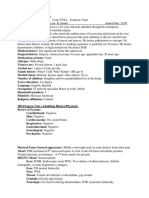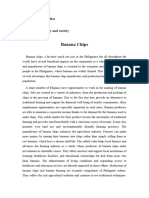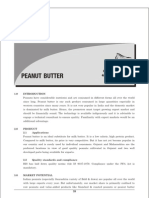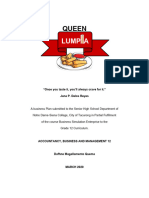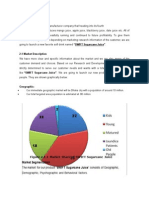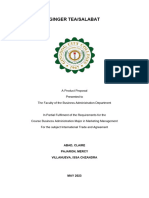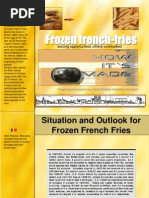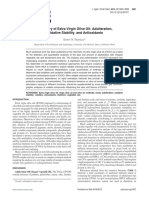Banana Chips
Banana Chips
Uploaded by
nez2194Copyright:
Available Formats
Banana Chips
Banana Chips
Uploaded by
nez2194Original Description:
Copyright
Available Formats
Share this document
Did you find this document useful?
Is this content inappropriate?
Copyright:
Available Formats
Banana Chips
Banana Chips
Uploaded by
nez2194Copyright:
Available Formats
BANANA CHIPS
Introduction
There are two different methods for making banana chips. One of these is to deep fry thin slices of banana in hot oil, in the same way as potato chips or crisps. The other is to dry slices of banana, either in the sun or using a solar or artificial dryer. The products made by the two methods are quite different. The deep fried chips tend to be a savoury, high calorie product that is eaten as a snack food. Because they are deep fried in oil they have a fairly short shelf life- up to 2 months maximum when stored in the correct conditions. The oil is prone to turning rancid and the crisps to becoming soft if they are not stored in air-tight containers.
Figure 1: Banana chips.
Photo: Neil Noble / Practical Action.
The dried chips are a more wholesome product. They too are eaten as a snack food and are often added to cereal mixes such as muesli. The chips can be dried without any additives or they can be coated with a syrup or honey dip prior to drying which gives a sweeter tasting, higher calorie and possibly more attractive looking product. Chips made by drying have a longer shelf life (up to 6 months) as long as they are dried to a low moisture content and stored in a cool dry place. Bananas can also be dried whole or in long strips until they are leathery and chewy. They have a higher sugar content and are not crispy like the dried chips. They are sometimes referred to as banana figs. This brief explains how to make fried banana and plantain chips and dried banana chips. Any starchy fruit such as under-ripe jackfruit (Artocarpus heterophyllus).
Fried banana chips
Principles of preservation Under-ripe mature banana or plantain is cut into thin slices and fried to a crisp texture. The slices can be partially dried before frying which removes some of the moisture and makes them more crispy. Frying removes some of the water, gelatinizes the starch, destroys enzymes and micro-organisms and gives a crisp product with a characteristic aroma and taste. The low moisture content inhibits microbial growth and packaging prevents recontamination. Equipment needed Knives or small fruit slicer Plastic buckets or bowls for soaking fruit Plastic sieve for draining the soak water Drying trays (solar drying) Drying cabinet (for assisted drying) Large frying pan or wok Thermometer Polythene bags Bag sealer
Practical Action, The Schumacher Centre, Bourton on Dunsmore, Rugby, Warwickshire, CV23 9QZ, UK T +44 (0)1926 634400 | F +44 (0)1926 634401 | E infoserv@practicalaction.org.uk | W www.practicalaction.org ______________________________________________________________________________________________ Practical Action is a registered charity and company limited by guarantee. Company Reg. No. 871954, England | Reg. Charity No.247257 | VAT No. 880 9924 76 | Patron HRH The Prince of Wales, KG, KT, GCB
Banana chips
Practical Action
Selection of raw material It is essential to use under-ripe green bananas as these have the correct texture for drying and frying. If plantain is used, select nearly ripe fruit that has stiff and starchy flesh. Ripe and over ripe bananas and plantains should not be used as the texture is too soft to make the chips. For banana figs, fully ripe fruits with a sugar content of about 20% are used. Preparation of raw material Bananas should be peeled just before they are used because when the flesh is exposed to the air it turns brown. This does not affect the eating quality but it does not look very attractive. Peeled bananas can be prevented from turning brown by brushing them with a solution of ascorbic acid (vitamin C) or the juice from lemon, lime or orange. Alternatively, the peeled banana slices can be soaked in a solution of citric acid (made by mixing 1 part lemon juice with 2-3 parts water) for 3-5 minutes. Do not leave the slices in the water for longer than this as they become too wet and soft and will take longer to dry. Remove the slices from the water and allow to drain. Slice the bananas crosswise or diagonally crosswise for the smaller bananas into slices that are about 5-8mm thick. Try to ensure that all pieces are the same thickness so that they all dry and fry at the same rate. A packet of banana chips of varying thicknesses is less attractive than one in which the pieces are of uniform thickness. You can use a small kitchen slicer to ensure that the pieces are of uniform thickness. Pre-treat the slices with acidified water, a solution of ascorbic acid, a fruit juice dip or a honey dip to prevent them from browning.
Ascorbic acid solution : Ascorbic acid (vitamin C) mixed with water is a safe way to prevent fruit
browning. In some places, ascorbic acid is available in the powdered or tablet form, from pharmacies or grocery stores. One teaspoon of powdered ascorbic acid is equal to 3000 mg ascorbic acid in tablet form. (If you buy 500 mg tablets, this would be six tablets). Mix 1 teaspoon of powdered ascorbic acid (or 3000 mg of ascorbic acid tablets, crushed) in 2 cups water. Place the fruit in the solution for 3 to 5 minutes. Remove fruit, drain well and place on the dryer trays.
Fruit juice dip: A fruit juice that is high in vitamin C can be used as a pre-treatment, though it is
less effective than pure ascorbic acid. Juices high in vitamin C include orange, lemon, pineapple, grape and cranberry. Each juice adds its own colour and flavour to the fruit. Place enough juice to cover the fruit in a bowl. Add the cut fruit and soak for 3 to 5 minutes. Remove fruit, drain well and place on dryer trays. This solution can be used twice before being replaced (the used juice can be consumed).
Honey dip: Mix 1 cup of sugar with 3 cups of boiling water. Add 1 cup of honey to the sugar mix
and stir to make a liquid dip. Either place the banana slices into the dip for 3-5 minutes and then remove, or brush the chips with the dip after they have been placed on the dryer tray. Dried banana chips dipped in honey are sweeter and have a higher energy value than those that are not dipped. Many of the commercially available banana chips have been dipped in honey or a syrup solution prior to drying. Fried banana chips Some processors partially dry the banana chips before frying them. This is to remove some of the moisture from the chips before drying, which results in crispier banana chips. However, during the time that they are drying, the banana slices are prone to darkening which reduces the quality of the final product. You can also fry the banana slices without drying them. If you soak them in a syrup or salt solution before frying, drain them well before drying to ensure that they are dry before they go in the oil. 2
Banana chips
Practical Action
Dry the sliced bananas for a short time (5-6 hours in a cabinet dryer or up to 2 days in a solar dryer) until they have a soft rubbery texture. The length of time taken for drying depends on the thickness of the banana slices, the temperature of the dryer and the drying conditions. Heat good clean vegetable oil to 180-200C. Use a thermometer to check the temperature of the oil because if it is too hot, the chips will burn and the oil will deteriorate more rapidly (see the box on quality of oil and frying). If the oil is not hot enough, the chips will soak up too much oil before they fry. A thermostatically controlled deep fat fryer is useful if you have one available. The oil should not be used for frying more than three to four times as it deteriorates each time it is heated and this will spoil the flavour of the chips. Add a few banana chips to the oil (enough so that one layer of chips fit into the pan). If you add too many chips at one time the temperature of the oil will drop and the chips will take longer to cook. Fry the banana chips. Remove them from the oil with a straining spoon when they rise to the surface of the oil and are a golden brown colour. The chips will cook very quickly, so take care that they do not burn. The more chips in the oil at any one time, the longer they will take to cook. It is useful to have a mesh basket for frying the chips as this enables you to remove them from the oil more quickly when they are ready. The chips are placed into the mesh basket, this is lowered into the hot oil, shaken a little to move the chips around in the oil and then lifted out as soon as the chips are golden brown. For larger operations, it is useful to have more than one basket so that one can be removed from the fryer, the oil allowed to return to the desired temperature and then a second basket is lowered in.
Fried banana chips - process flow-chart
Green, under-ripe bananas Peeling (as quickly as possible to avoid browning) Soaking in citric acid or ascorbic acid solution Slicing into 5-8mm thick slices, ensure uniform size pieces Soaking in ascorbic acid, honey dip or citric acid solution for 3-5 minutes Drain Drying for 5-6 hours at 60C (optional) until rubbery texture Frying (180-200C) until golden brown Drain out oil Cooling Spicing Packaging Storage in a cool place away from direct sunlight. Up to 2 months
Banana chips
Practical Action
Leave the chips in the basket to drain off the excess oil (collect this oil as it can be returned to the fryer and re-used). When the chips have cooled slightly, and while they are still sticky with the warm oil, add the desired flavourings - for example salt, pepper or chilli powder. Cool to room temperature, weigh into moisture proof, airtight bags, label and seal the bags. Store the bags in a cool place away from direct sunlight. The fried chips have a short shelf life of about 2 months, so make sure that they are sold or consumed well within this time.
Plantain chips
A similar fried product can be made from green plantain, which is a cooking banana. The slices of plantain are fried in palm oil and sprinkled with salt. The palm oil gives the chips a reddish golden colour. The chips are about 2mm thick, have a crisp texture and a starchy, salty taste. They have a shelf life of 2-3 months if packed in moisture proof packets and stored in a cool place. Selection and preparation of raw material Use nearly ripe fruit in which the flesh is stiff and starchy over-ripe fruit cannot be used as the texture is too soft. Wash well in clean water to remove dirt and surface micro-organisms. Remove the skins. Only peel the plantain when you are ready to use them or the flesh will start to turn brown. Store the peeled plantain in acidified water (1 part lemon juice to 2-3 parts water) to slow down the browning reaction. Cut by hand or using a manual slicer to give slices approximately 2mm thick. Make sure that the slices are all uniform thickness so that they cook at the same rate. Soaking of slices Dip the slices of plantain in a solution of 5% salt for 10-20 minutes. Remove from the water and drain to remove the excess water. Fry Place the chips in a mesh basket and lower into the oil. Deep fry in palm oil at about 150C for 2-3 minutes until crisp and golden. Lift out the basket as soon as the chips are golden brown. Leave the chips in the basket to drain off the excess oil (collect this oil as it can be returned to the fryer and re-used). For larger operations, it is useful to have more than one basket so that one can be removed from the fryer, the oil allowed to return to the desired temperature and then a second basket is lowered in. Make sure that the temperature of the oil does not get too high or the chips will burn. If available, use a thermostatically controlled fryer. If not, use a thermometer to check the temperature. Do not use the frying oil more than 3-4 times as it will start to turn rancid and give the chips an off flavour. When the chips have cooled slightly, and while they are still sticky with the warm oil, add the desired flavourings - for example salt, pepper or chilli powder. Cool to room temperature, weigh into moisture-proof, airtight bags, label and seal the bags. Store the bags in a cool place away from direct sunlight. The fried chips have a short shelf life of about 2 months, so make sure that they are sold or consumed well within this time.
Banana chips
Practical Action
Oil, frying and quality control Most oils used for frying are of vegetable origin but there is no reason why animal fats cannot be used. The oil used has a great impact on the taste, texture and keeping quality of the final product. For example, palm oil gives products a red colour. Mustard seed oil gives fried foods a distinctive sulphur-like flavour. Fats and oils are subject to a type of deterioration known as rancidity. This produces disagreeable odours and flavours and makes the fried foods unpalatable. Some oils are more prone to rancidity than others and this is important when considering which oil to use. In many countries, however, there is only one type of oil widely available at the lowest cost and processors will use this, despite rancidity problems, if it gives a flavour that is acceptable. The amount of oil required for frying will vary according to whether the product is to be shallow fried or deep fried. The temperature to which the oil is heated is not limited by a boiling point as with water. Heated oil does however reach a stage at which it breaks down to fumes, which is known as the smoke point. It is important that oils do not reach the smoke point when used for frying as this will cause the oil to deteriorate more rapidly and increase the danger of it catching fire. Suitable temperatures for frying are between 180 and 200C. Frying can take place using a simple pan heated by an open fire or other heat source. Alternatively, for deep frying, an electrically powered fryer fitted with a thermostatic control gives more control over heating for larger quantities of food. At the end of the frying operation, the oil should be left to cool and then filtered to remove all particles of food that have accumulated in the bottom of the pan or fryer. These burnt pieces of food will cause the oil to spoil more rapidly. The cost of oil is one of the major factors to calculate when considering starting to produce fried chips. The quality of the finished product is highly dependent on having good quality, clean oil.
Sun-dried banana chips
Sun-dried banana chips are a popular snack food. They are made by drying the banana pieces on trays under the sun. A solar dryer or cabinet dryer can be used if available both these interventions will produce higher quality banana chips. See the Practical Action technical briefs on drying for further information on the practicalities of drying at the small scale. Equipment needed Knives or small fruit slicer Plastic buckets or bowls for soaking fruit Plastic sieve for draining the soak water Drying trays (solar drying) Drying cabinet (for assisted drying) Polythene bags Bag sealer Selection and preparation of raw material The selection and preparation of raw material is the same as for fried bananas above. Drying After soaking the banana slices in honey, syrup or fruit juice dip, drain the pieces well and place on the drying tray. If you do not want to soak the pieces prior to drying, it is possible to paint with a honey solution once the slices are laid on the drying trays. Place the pieces as close together as possible on the drying trays to ensure the maximum drying capacity. The pieces must not be touching or overlapping each other. If drying outside in the sun, cover the tray with a piece of muslin cloth to protect from insects and dust. Place in the drying position or into the solar dryer. If you are using a cabinet dryer, dry the pieces at 60C. 5
Banana chips
Practical Action
Leave the pieces in the dryer until they are crispy and dry the length of time taken will vary according to the type of dryer used, the climate and the level of humidity. Do not dry too quickly or the pieces may dry on the outside before the middles are fully dry. Remember that the banana slices will discolour during drying. To maintain a good bright colour, the drying process should be as short as possible.
Dried banana chips - process flow-chart
Green, under-ripe bananas Peeling (as quickly as possible to avoid browning) Soaking in citric acid or ascorbic acid solution Slicing into 5-8mm thick slices, ensure uniform size pieces Soaking in honey dip or syrup solution for 3-5 minutes Drain Drying for 8 hours at 60C or 1-2 days in a solar dryer Packaging Storage in a cool place away from direct sunlight. Up to 2 months
After drying, cool to room temperature and package in moisture-proof packaging. Label and store in a cool place away from direct sunlight.
References and further reading
Drying of Foods Practical Action Technical Brief Small-scale Drying Technologies Practical Action Technical Brief Banana Beer Practical Action Technical Brief Adding Value to Bananas Food Chain 21, July 1997, Practical Action Traditional Foods: Processing for Profit by P. Fellows, Practical Action Publishing, 1997 Practical Action Bangladesh has produced a booklet on green banana chips production in Bangla. This document was produced by Dr. S Azam Ali for Practical Action in March 2008. Dr. S Azam-Ali is a consultant in food processing and nutrition with over 15 years experience of working with small-scale processors in developing countries.
Practical Action
The Schumacher Centre Bourton-on-Dunsmore Rugby, Warwickshire, CV23 9QZ United Kingdom Tel: +44 (0)1926 634400 Fax: +44 (0)1926 634401 E-mail: inforserv@practicalaction.org.uk Website: http://practicalaction.org/practicalanswers/
Practical Action is a development charity with a difference. We know the simplest ideas can have the most profound, life-changing effect on poor people across the world. For over 40 years, we have been working closely with some of the worlds poorest people - using simple technology to fight poverty and transform their lives for the better. We currently work in 15 countries in Africa, South Asia and Latin America.
You might also like
- The-Mediterranean Diet CookbookDocument123 pagesThe-Mediterranean Diet CookbookTramat Hanoi100% (8)
- Carbs and Cals - SAMPLE Carb and Calorie CounterDocument49 pagesCarbs and Cals - SAMPLE Carb and Calorie CounterMonkey D Nando100% (2)
- Heart Disease Case StudyDocument13 pagesHeart Disease Case Studyapi-284823421100% (2)
- Market Segmentation Heinz KetchupDocument10 pagesMarket Segmentation Heinz KetchupAayush Agnihotri67% (3)
- Refineries in TN and KarnatakaDocument5 pagesRefineries in TN and Karnatakashaji deloitteNo ratings yet
- Business Plan Village Based Banana Processing ProjectDocument27 pagesBusiness Plan Village Based Banana Processing ProjectNived Lrac Pdll Sgn67% (3)
- Marketing Plan Coco Sugar: Situation AnalysisDocument12 pagesMarketing Plan Coco Sugar: Situation Analysisqwerttrewq100% (2)
- Pineapple WineDocument22 pagesPineapple Wineyin2783% (6)
- Bottled Coconut Water TrishnaDocument25 pagesBottled Coconut Water TrishnaRolando MurilloNo ratings yet
- Meal PlanningDocument4 pagesMeal Planningvega100% (1)
- Edible Oils in The Philippines AnalysisDocument2 pagesEdible Oils in The Philippines AnalysisArisa HanamiNo ratings yet
- Virgin Olive Oil - Production, Composition, Uses and Benefits For Man (2014) PDFDocument406 pagesVirgin Olive Oil - Production, Composition, Uses and Benefits For Man (2014) PDFAndré Campelo100% (3)
- Banana ChipsDocument1 pageBanana ChipsMHAREZ JOY ALICABO100% (1)
- Banana Flour ProcessingDocument3 pagesBanana Flour ProcessingLeilani Delgado MoselinaNo ratings yet
- Banana Peel VinegarDocument2 pagesBanana Peel VinegarJoe-Jean Laurio100% (1)
- Marketing PlanDocument3 pagesMarketing PlanDENDEN100% (1)
- Chapter 1 FsDocument6 pagesChapter 1 FsNijinette TechezlarNo ratings yet
- Business PlanDocument18 pagesBusiness PlanDevita regaNo ratings yet
- Executive SummaryDocument19 pagesExecutive SummaryRykad Computer solutionsNo ratings yet
- FnaaaaaaaaaaaaaaaaaaaaaaaaaaalllllllllllllDocument22 pagesFnaaaaaaaaaaaaaaaaaaaaaaaaaaalllllllllllllJohn Joshua100% (1)
- Business Plan - Peanut Butter - Senior CitizensDocument1 pageBusiness Plan - Peanut Butter - Senior CitizensNa LynNo ratings yet
- Banana ChipsDocument2 pagesBanana Chipsjairadedios530% (1)
- Banana Production & ProcessingDocument8 pagesBanana Production & ProcessingLeilani Delgado MoselinaNo ratings yet
- Marketing PlanDocument9 pagesMarketing PlanDipock Mondal100% (2)
- Potato and Banana ChipsDocument6 pagesPotato and Banana ChipsNikhil KumarNo ratings yet
- Market Potential of Banana Chips Industry in MalaysiaDocument8 pagesMarket Potential of Banana Chips Industry in MalaysiaMARDI ScribdNo ratings yet
- Banana Flour ProductionDocument18 pagesBanana Flour ProductionClaudric Adams50% (2)
- Bananas Bananaindustry Bananachips: PHL Banana Industry Pins Hope On Chips For Revenue TagsDocument4 pagesBananas Bananaindustry Bananachips: PHL Banana Industry Pins Hope On Chips For Revenue TagsJonah Nobleza0% (1)
- Analysis OF Business Feasibility OF Banana Chips: Ruswaji, Puguh CahyonoDocument4 pagesAnalysis OF Business Feasibility OF Banana Chips: Ruswaji, Puguh CahyonoAra EntomaNo ratings yet
- 12ABM-D4 LaPanaderiaChapter3Document21 pages12ABM-D4 LaPanaderiaChapter3Patricia JuriaNo ratings yet
- Iv. Technical Aspect 4.1 ProductDocument6 pagesIv. Technical Aspect 4.1 ProductFaith LacreteNo ratings yet
- B - ChipsDocument27 pagesB - Chipsshahreen arshadNo ratings yet
- Supply Chain Improvement For The Banana (Saba) Industry in Cagayan Valley - An Evaluation ResearchDocument19 pagesSupply Chain Improvement For The Banana (Saba) Industry in Cagayan Valley - An Evaluation Researchdarjv1230% (1)
- The Project Feasibilty Study and Evaluation - Aj. Chaiyawat Thongintr. Mae Fah Luang University (MFU) 2010Document102 pagesThe Project Feasibilty Study and Evaluation - Aj. Chaiyawat Thongintr. Mae Fah Luang University (MFU) 2010tortao889010No ratings yet
- Banana FlourDocument9 pagesBanana FlourLailaNo ratings yet
- Agribusiness Study PhilippinesDocument16 pagesAgribusiness Study PhilippinesDenis SalvatierraNo ratings yet
- 08 Peanut ButterDocument11 pages08 Peanut ButterMichael WambuaNo ratings yet
- ChipsCo Business PlanDocument56 pagesChipsCo Business PlanNishi JainNo ratings yet
- Assessment of The Suitability of Banana: (Musa Acuminata) Flour For Domestic FoodDocument29 pagesAssessment of The Suitability of Banana: (Musa Acuminata) Flour For Domestic Foodedvin100% (2)
- Potato ChipsDocument11 pagesPotato Chipsginish12No ratings yet
- Tamil Nadu Rural Transformation Project Business Plan For Banana Chips Manufacturing UnitDocument19 pagesTamil Nadu Rural Transformation Project Business Plan For Banana Chips Manufacturing UnitRoxanne Jane Carandang100% (2)
- Business PlanDocument7 pagesBusiness PlanShara ValleserNo ratings yet
- Banana ChipsDocument26 pagesBanana ChipsKenneth Arroyo50% (2)
- Final DefenseDocument96 pagesFinal DefenseKingChryshAnne100% (2)
- Feasibility Study of Soya ProductDocument18 pagesFeasibility Study of Soya ProductSorabh Dung0% (1)
- Akkufinal - Peanut ButterDocument9 pagesAkkufinal - Peanut ButteradarshNo ratings yet
- Business Plan Potato FrittersDocument43 pagesBusiness Plan Potato Frittershayat0175% (4)
- Banana Chips Final Report RoshanDocument32 pagesBanana Chips Final Report RoshanROSHAN KHALIDNo ratings yet
- Business PlanDocument9 pagesBusiness PlanJana Delos ReyesNo ratings yet
- Haske Parboiled RiceDocument33 pagesHaske Parboiled RiceAbiodun Ali100% (1)
- Coco Fresh-Manendra ShuklaDocument50 pagesCoco Fresh-Manendra ShuklaAdityaKumarNo ratings yet
- Angela Business PlanDocument11 pagesAngela Business PlanAgatha Dominique BacaniNo ratings yet
- Marketing Plan of Swift Sugarcane JuiceDocument12 pagesMarketing Plan of Swift Sugarcane JuiceParvezMridhaNo ratings yet
- Ginger TeaDocument14 pagesGinger TeaMercyNo ratings yet
- Banana Chips IndustryDocument3 pagesBanana Chips IndustryNeil Mahilum DeclaroNo ratings yet
- Ayeni Deneice Project EditedDocument54 pagesAyeni Deneice Project Editedmercydebby17No ratings yet
- Gainbc Special Banana Crackers: Misamis UniversityDocument6 pagesGainbc Special Banana Crackers: Misamis UniversityJed EnricusoNo ratings yet
- Potato Frozen French FriesDocument44 pagesPotato Frozen French FriesIssam El Baba100% (14)
- Dragon Fruit JAM Marketing PlanDocument31 pagesDragon Fruit JAM Marketing PlanLara Rinoa LarrozaNo ratings yet
- Business Plan Proposal: A.Mabini St. Caloocan City Near CCMCDocument13 pagesBusiness Plan Proposal: A.Mabini St. Caloocan City Near CCMCVicky rederaNo ratings yet
- FIJI - Dried Mango Value ChainDocument65 pagesFIJI - Dried Mango Value Chainflashbulb690% (1)
- Finalfeasib Copy 2Document84 pagesFinalfeasib Copy 2Angelica BautistaNo ratings yet
- Potato Chips CompanyDocument48 pagesPotato Chips Companyshani2783% (6)
- Food Outlook: Biannual Report on Global Food Markets May 2019From EverandFood Outlook: Biannual Report on Global Food Markets May 2019No ratings yet
- Fruit LeatherDocument5 pagesFruit LeatherZulman EfendiNo ratings yet
- Mangoes Are Very Abundant in The PhilippinesDocument19 pagesMangoes Are Very Abundant in The PhilippinesCHRISTIAN F. MAYUGANo ratings yet
- Study of Fatty Acid Profile in Edible Oil and Used Cooking OilDocument50 pagesStudy of Fatty Acid Profile in Edible Oil and Used Cooking OilDhanasekar VNo ratings yet
- 4th GradingDocument7 pages4th GradingCHAPEL JUN PACIENTENo ratings yet
- Fssai License-Super SipsDocument6 pagesFssai License-Super Sipstushar.tiwariNo ratings yet
- Import of Edible Oil in India: Ashish Chhajer PGDM5/1812Document5 pagesImport of Edible Oil in India: Ashish Chhajer PGDM5/1812ashish chhajerNo ratings yet
- Dalda PakistanDocument5 pagesDalda Pakistanumer bin abid100% (2)
- Extraction of Cottonseed Oil Expeller Method One Ton Per Day PDFDocument2 pagesExtraction of Cottonseed Oil Expeller Method One Ton Per Day PDFHenryNo ratings yet
- AS Factory Fssai LicenseDocument6 pagesAS Factory Fssai LicenseDhiraj Ranjan RayNo ratings yet
- Tường AnDocument47 pagesTường Anthinh17112002No ratings yet
- Cargill VinodDocument98 pagesCargill Vinodsaurajindal09No ratings yet
- Generalvalue Chain Analysis Soybeans MalawiDocument67 pagesGeneralvalue Chain Analysis Soybeans MalawideepashajiNo ratings yet
- Category Brand Name Product Name Product Code HSN Code Sub-CategoryDocument5 pagesCategory Brand Name Product Name Product Code HSN Code Sub-CategorySanjay SahuNo ratings yet
- Chemistry of Extra Virgin Olive Oil Adulteration, Oxidative Stability, and AntioxidantsDocument16 pagesChemistry of Extra Virgin Olive Oil Adulteration, Oxidative Stability, and Antioxidantsm.cj1No ratings yet
- Reviewoilunitedjournal PDFDocument9 pagesReviewoilunitedjournal PDFZenaw AntenbiyeNo ratings yet
- Physical Properties of Palm OilDocument9 pagesPhysical Properties of Palm OilIman Pujitrianto100% (1)
- Pricing Strategies of Edible Oil: With Focus On Greater GhaziabadDocument19 pagesPricing Strategies of Edible Oil: With Focus On Greater Ghaziabadsahilk63No ratings yet
- Coconut Oil Benefits ForDocument4 pagesCoconut Oil Benefits ForB GirishNo ratings yet
- Commercial Uses of SugercaneDocument27 pagesCommercial Uses of SugercaneAisha AshrafNo ratings yet
- BiomoleculesDocument11 pagesBiomoleculesAdul basit mughalNo ratings yet
- Cold Pressed Avocado OilDocument8 pagesCold Pressed Avocado OilNishantha AriyadasaNo ratings yet
- QR Scientifique Technique EN 011119Document29 pagesQR Scientifique Technique EN 011119Vio CondreiNo ratings yet
- DaldaDocument4 pagesDaldaMuhammad UmairNo ratings yet
- Ir Nutrition Guide enDocument27 pagesIr Nutrition Guide enCelia Gómez GarcíaNo ratings yet
- BF EupalmoilDocument23 pagesBF EupalmoilEsther van LuitNo ratings yet


